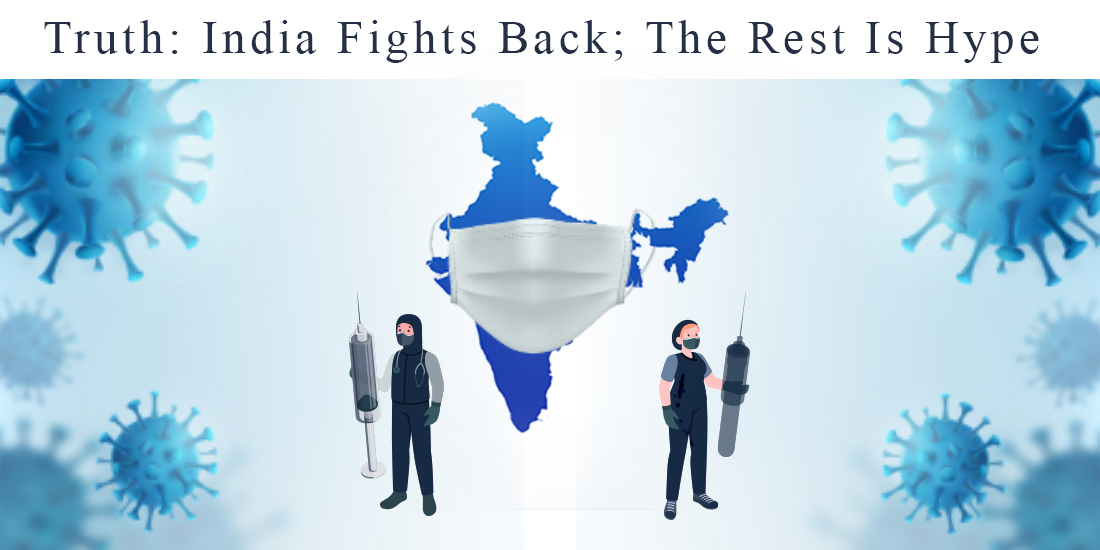
There are no second thoughts that India is facing a tough situation. With a population of 1.38 billion spread across a land mass of 3.28 million square kilometres, any pandemic situation is not easy to handle. Even as I write this piece, the city of Mumbai, which was recording 10,000 to 11,000 new CoVid 19 cases every day at the beginning of April 202l, with a daily positivity rate of 20 to 30 per cent, has seen a steady decline in the number of new cases each day. Over the past three days, Mumbai has been adding less than 4,000 daily cases to its CoVid 19 tally. The whole world, save some, is in a reactionary mode.
When combined with the penchant of some sections of the population not willing to follow safe practices either out of ignorance or apathy, the situation does become alarming. Further there are media folks who have not written with factual data in hand and presented a one sided imbalanced picture. This note is probably being written at a time when the country is in the eye of the storm and showing how it is combating the crisis. And mark my words, this is a crisis which has little precedent to fall back on in terms of how it could have been handled and has put everybody on the same mat. It may well change the world order.
What are the key issues that the country faces today?
First and foremost is the issue of coverage. While it may be desirable to cover 1.38 billion people in a short period of time, we can see that as on date, around 10% of the Indian population has been vaccinated. In numbers this is around 148 million people who have taken at least the first dose of the vaccine. Data from ourworldindata.org clearly indicates that some other countries have moved ahead in terms of their vaccinations in percentage and a few in absolute terms. However, this needs to be seen in terms of the size of the population and the sheer distance that the vaccines need to traverse to reach all parts of the country.
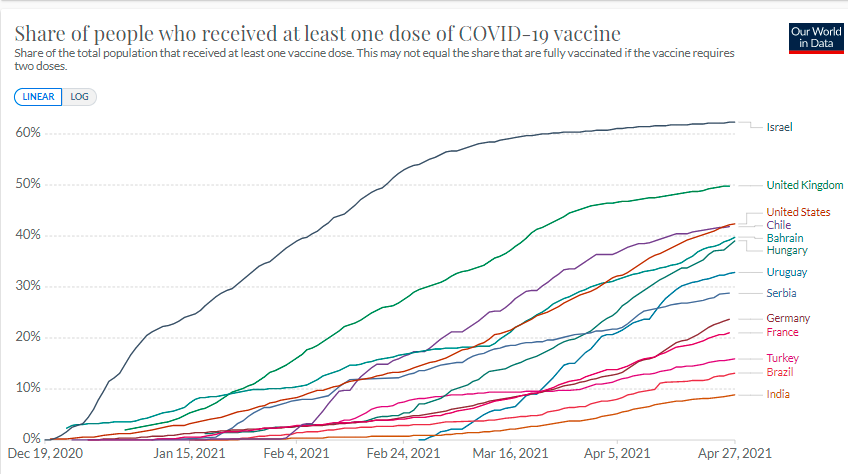
Israel, which has done an excellent job in vaccinating 62.26% of its population as on April 27, 2021, has a population of around 8.66 million spread over 22,000 square kilometres. The United States with a population of 331 million spread over 9.83 million square kilometres has succeeded in vaccinating around 42.15% of its population which is around 139 million people. And this is a country which has relatively superior infrastructure as compared to the less stable infrastructure of the Indian subcontinent. Thomas Friedman said “The World is flat, I say it is flatter now.”
Despite these constraints, it must be stated that the rate of growth in vaccine coverage has been steadily increasing with strong support from those in governance with frontline health warriors as the servicemen, namely the public and private healthcare system going much beyond the call of duty. It is a war-like situation with a faceless enemy that the world is facing.
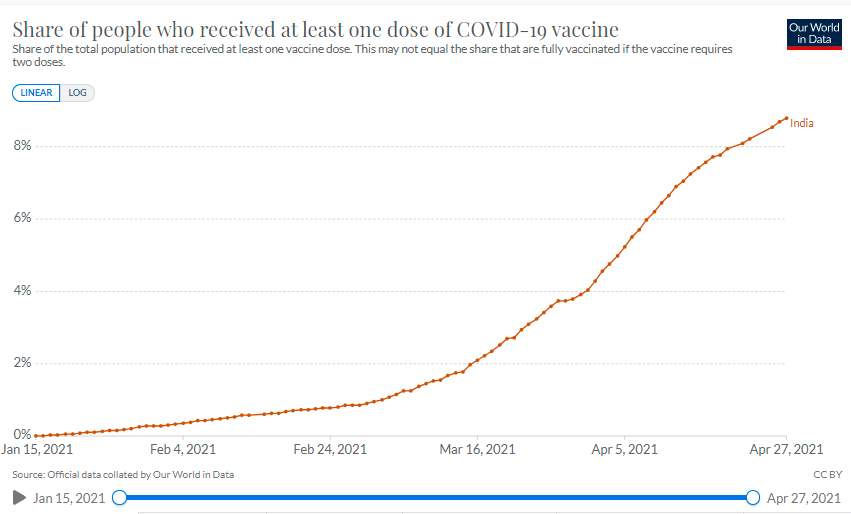
Second, we must also consider this statistic with a realistic estimate of the number of fatalities per million of population. Though it is downright sad to see any loss of life, the number of deaths per million suggest that the recovery rates in India had been holding steady for a long time and the negative streak showed a spike only in the last few days. It must be noted that the large states of India have a very high share of vaccinations done. India’s mortality rate per million is at rank 81 is 144 per million, while the US is ranked 14th with 1,739 deaths per million.
The macabre photographs being broadcast in some sections of the media seem to suggest that everything is wrong with the country and that is a colored view. The reality is that all sections of the society and stakeholders, the civil servants, doctors, those in governance are fighting it with courage and conviction. The country has been inspired.
A simple study of this graph shows that the number of deaths per million in India has been range bound till almost March 30, 2021, and showed a spike after that. This spike is expected to be arrested soon thanks to the increased vaccine coverage and strict enforcement of rules and regulations in containment zones besides normal plateauing effect after the peak.
The third issue that one needs to consider is the availability of oxygen for Covid 19 patients; some of whom may need it. It is estimated that the country has around 2.5 million patients out of which around 5-10% need oxygen. This translates in numerical terms of a demand of around 250,000 oxygen cylinders. This admittedly is a problem. India has an oxygen production capacity of 7,127 metric tonnes per day as against demand of 6,600 metric tonnes per day now. Most of production today has been earmarked for medical uses.
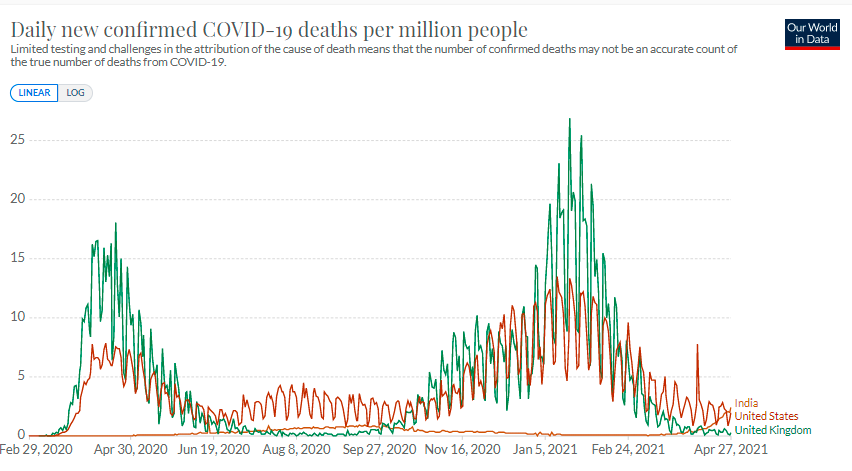
Before the pandemic hit the country, the requirement of liquid medical oxygen was just 700-800 metric tonnes per day; the current surge in demand is 10X. The issue is not the production capacity but storage and transportation too. It is not possible to create the supply and logistics chain to attend to this 10x normal demand overnight. This can be a challenge for any country to meet in a very short period of time, but we have made inroads .
Authorities at the Central and State Levels have taken various steps to curtail the supply of oxygen for industrial purposes to ensure that most of the oxygen production is available for medical needs. With just around 2,000 cryogenic tankers available for oxygen distribution, the authorities have stepped up efforts to create Oxygen Express trains to help deliver oxygen across the length and breadth of the country from the source. Some States are setting up their own oxygen production plants, some have placed orders for additional cryogenic tankers and have floated tenders to import 50,000 metric tonnes of oxygen. The Air force has even airlifted tankers from other countries. The humanitarian aid provided by India in terms of HCQ, medicines to large and small countries alike, including ones hostile to India, is now being reciprocated by many. Though not published, the undercurrent of being with India globally is very high.
Another issue which stresses the vaccination drive is the question of capacities. This coupled with the marked denial for a period of time by certain countries to export critical raw materials to India, put an added spoke in the stocking and distribution of vaccines. The present capacity of manufacturing vaccines is spread over Serum Institute which can produce around 60-70 million doses per month and Bharat Biotech which can do around 10 million doses per month. With Russia’s Sputnik vaccine coming in with some support, the situation will ease slightly but it will be some time before the country will be out of the woods. Both Serum Institute and Bharat Biotech are stepping up their production capacities to 100 million doses per month by each of them, but the full impact of this will be felt by September 2021. Bharat Biotech is stepping it up on a gradual basis while Serum Institute is expected to reach 100 million doses by July 2021. Why this issue assumes importance is that if the country desires to vaccinate 50% of its population (excluding the young population) with two doses each, it would need 1.38 billion doses of vaccine. The maximum that Serum and Bharat Biotech can provide on a combined basis from September is 200 million doses per month. The math indicates that it will be at least a good six months, keeping transportation issues in mind, before 50% of the country gets vaccinated and possibly reaches herd immunity. The period will come down with the addition of stocks from imports and stepped up manufacturing in the country.
Continuing on the vaccine issue, a programme of this size will definitely have a cost impact; much has been written about this factor. It is the considered view of this writer that this impact is most certainly going to be felt, but it is not large enough to warrant knee jerk reactions and fear mongering. Going by the above mentioned statistic of 1.38 billion doses @ global price USD 6.5 per dose, this will stress the GDP by means of an unforeseen allocation of USD 8.97 billion. However the cost of vaccination to the Indian exchequer is expected to be between $2 and $4 per dose; thus the impact may be lesser than expected. With our GDP level close to USD 3 trillion, this will amount to around 0.15% of the GDP, which the economy should be able to absorb with minimal discomfort.
This brings us to the current issue of what the country is doing right now in terms of treating the people who are already infected with CoVid 19. One of the drugs prescribed on an emergency basis for the treatment of CoVid19 is Remdesivir. The truth be told, it is still not fully clear as to how effective Remdisivir is in the treatment of CoVid 19, which is not needed in all cases. After the first wave declined, the manufacturers of Remdesivir cut back production. However, the installed capacity exists which is around 3 million vials per month and the authorities have directed all the manufacturers of the drug to push production levels close to 4 million vials per month. However, it may take a few days to complete the manufacture and distribution of the drug across the country. It is estimated that it takes around 20 days to manufacture, test and distribute the product. The current demand is around 100,000 doses per day and Gilead is stepping in with 450,000 doses. Those in governance are taking steps to distribute 1,000,000 doses on a war footing. The moot point here is that it is going to take a few days for the distribution of the drug across the country.
While we all keep talking about the general measures of providing Vaccines, Medicines and Oxygen, a little known fact is the role of Indian Railways, a government entity. Apart from transporting Oxygen from different parts of the country, through corridors , using Oxygen Express. The Railways have also created a Unique Infrastructure. Very quickly , they have created beds, by transforming railway coaches fully loaded with beds, air coolers and facilities for Oxygen. This is a very forward looking move that is revolutionary. Indian Railways have within the last 9 months created 66,000 beds out of 825 Railway coaches, of which 2,990 have been put to use in various parts of the country. Can you imagine that this is equal to putting up 220 hospitals each of 300 beds in a flash?
An important issue of shortage of Doctors and Nurses at the moment.. This frontline group are the most stressed out and have been working day and night. Years of neglect in medical education, not building up capacity is now hindering us and needs to be immediately rectified. Telemedicine is one of the alternatives. The Armed Services Medical Corps is also on the job and have even called retired medical officers to rejoin the team, until the crisis blows out. However all this is a stop gap measure , but we have to provide for more seats and the private sector will have to be allowed.
Going forward, we believe as some other economists do that the world and India in particular will bounce back from this situation. The short term pain for some sections of the economy such as those in the MSME sector relying on daily commerce and the people dependent on these sections will face discomfort. However, it is our belief that as we step into the situation of herd immunity, the pent up demand will be unleashed and India’s GDP growth will hit the 10% plus mark (Nomura estimates it to be 11.5%; Standard and Poor estimates it to be 11%) and will be back on the growth trajectory
I have been speaking to a few of my fund managers and medical professionals during this particularly difficult times. Here are some of the views presented:
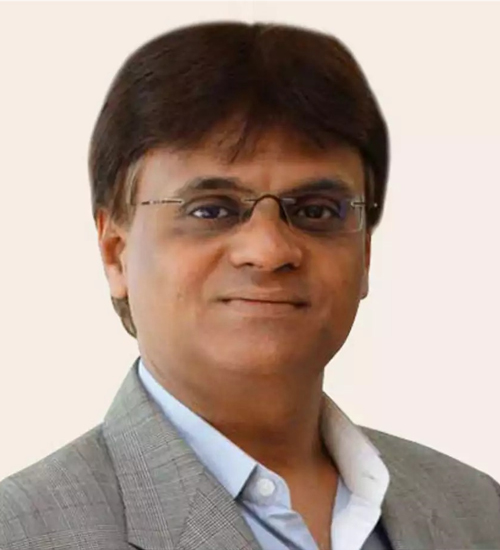
Mr. Deven Choksey
Promoter, KRChoksey Group, India
Managing Director, KRChoksey Shares and Securities Pvt. Ltd., India
Second wave of COVID has been an eye opener for the country. I am very positive, India will emerge stronger from this crisis in building healthcare infrastructure and build healthcare tourism!...Read More
Almost 10% of her 138 billion population is vaccinated and by August it promises to vaccinate about 35-40% of the population.
Later half of 2021 & 2022 looks promising for India also economically, as the country will have improved health of her people.

Dr. Vinit Samdani
Paediatrics, Breach Candy Hospital, Mumbai, India
We must be careful but remember everything is not locked down. Sunrise, love, relationship, friendship, family time, responsibility, creativity, prayers and oxygen in air are not locked.
Do what you want to do but at Home.Read More
Masks are better than ventilators.
Home better than hospital
Prevention better than cure
Vaccination to be taken by prior appointment, social distancing as we don’t want the vaccination centres to turn into super spreaders!!
We are responsible and must behave responsibly to help the country and the government to get control of the pandemic for a better tomorrow.

Mr. Gerard J. Benares
Head of Operations, Compass Group LLC Fund Managers, Fund Admin, New York, USA
It will be worst until it gets better. The country will overcome this temporary setback. The world reacts with good intentions but the some in the press with their usual slant Read More to exaggerate will magnify the pejorative and render India helpless for their personal gain. Your resolve must be firm, filled with pro activity to demonstrate to the world resilience and purpose in Order to win over the pandemic.
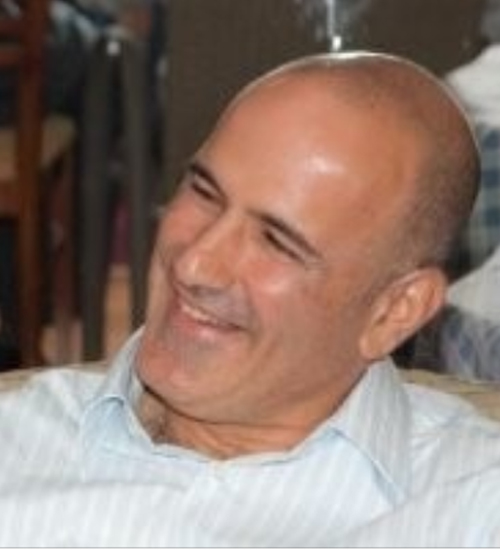
Mr. Gavriely Nissan
Director, Head Office of Poalim Mutual & Hedge Funds Services at Poalim Financial Holdings1993 Ltd., Tel Aviv, Israel
Many people both inside and outside of India have questioned Prime Minister Modi’s response to controlling the virus. If we recall, in February and March it looked like things in India were getting under control, Read More but then the “double mutation strain” came out and started to spread. It would not be fair to criticize the action of nature on Prime Minister Modi. From what I have read and seen on the news, India, with the help of the US, Israel, the UK and other nations has rebooted its war on this devastating virus. We know India well and we know it will prevail.

Mr. Howard Seligmann
Country Director, Basiz Fund Services Group, North America
As the second wave of the global Covid crisis has touched India, we see that there is not one nation on the planet that is immune from its severity.Read More We also know, that despite the havoc it has brought to us, India will recover and continue its role as a leading economic power for the betterment of our people and the world.
Article concept origination, content direction by CA.Aditya Sesh Founder MD of Basiz Fund Services. Content & data aggregation and development by Dr. Viswanath Krishnan & R.Chandra-Strategic team @Basiz.
